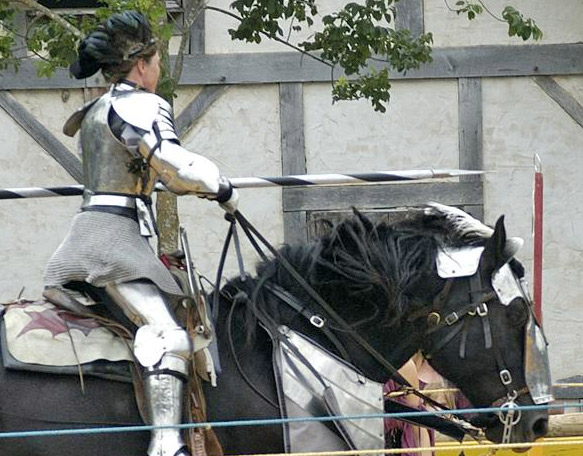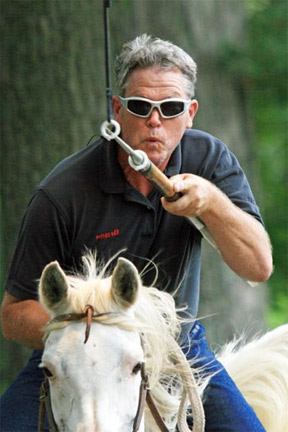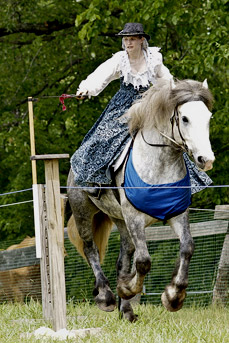|
Tampa's Rings Tournaments
In the late 1800s, Tampa was a friendly town and moreover, few persons believed in letting work interfere too much with pleasure. People often took time off from their daily chores to enjoy themselves. During the long summer months, picnics on the beaches and excursions on the bay were common events. Every week or so, some group held a lawn fete, entertainment or dance. Many of the young men belonged to the "Tampa Rifles" and spent much time drilling or parading through the streets. During the winter, plays were given by members of the Tampa Amateur Dramatic Society.
The winners had the honor of choosing the Queen of Love and Beauty and her two maids of honor. The queen always was crowned at a ball held two days after the tournament. It was the big social event of the season and everyone socially prominent attended.
The first accounts of "Running at the Rings" dates to the days of James I of England demonstrating a knight's extreme skill, since the rings were obviously much smaller to lance than a man. The death of several nobles and at least one king, King Henry II of France in 1559, brought about the demise of the man-to-man type of jousting. It was also during this time that gunpowder was introduced into Europe from the Orient. Guns made warfare by horse-mounted lancers obsolete overnight. Although the precise evolution of ring jousting is not known, history does provide us with many well-documented great tournaments throughout the next several centuries. Cecil Calvert, Lord Baltimore, of the "colonies" is reported to have been the first to introduce jousting here. Jousting in Europe has declined whereas Americans, on the other hand, have built interest steadily. The first tourney of which there is any record for Tampa was held January 2, 1877. Seventeen young gallants were the contestants. W.B. Henderson and Wm. Washington "Billy" Wall were the judges and James E. Lipscomb, the marshal. Thomas E. Jackson, the Knight of Reform, had high score and named Miss Etta Warner the queen. Dr. Thomas S. Daniel, who was "Oswald," took 2nd place and named Miss Ada McCarty the queen's maid of honor. Wesley P. Henderson, the Knight of Florida, took 3rd place, and named Miss Mamie Parish the second maid of honor.
The Ring Tournament was held each year on the parade ground in the [Ft. Brooke] garrison. At other times, the parade ground was the favored grazing land of a small herd of cows owned by Mrs. Benjamin Cowart, known to everyone as "Granny" Cowart. Each evening the cows were driven from the garrison through the streets to Granny's cow pen on the northeast corner of Tampa and Lafayette Streets, now in the heart of the business district. In 1883, Granny Cowart had to take her cows out of the Garrison, the Tampa Rifles had to go somewhere else to drill, and the Knights of Hillsborough had to begin looking for another place to hold their tournaments. Because in that year Fort Brooke passed out of the possession of the Federal government.
PDF: A history of the city of Tampa and the Tampa Bay region of Florida By Karl Grismer, citation from USF Library Click banner to visit ...
|
|

 Each year at Christmastime in the late 1800s, the Knights of Hillsborough
held their Ring Tournament. This annual event was something like the
knightly tournaments held in Merrie England back in the medieval times.
But instead of jousting each other off their horses, the gaily costumed knights
tilted their lances at three rings suspended ten feet off the ground from
horizontal bars. Each rider had three tries and if he was a fine horseman
and had nerves of steel, he could get nine rings. In accordance with the
rules of the sport, each rider is given three rides or charges at the so-called
large rings, which are one inch in diameter. It is possible to have a total
score of nine rings on three rides, since the knight has a chance to spear three
rings on each charge. After all the knights have completed their three turns,
the rings are reduced in size to three-quarters of an inch in diameter, and all
the riders with a perfect score on the larger rings are allowed to have one ride
on rings of this size. Subsequently the remaining riders with a perfect score
again ride on rings of one-half inch in diameter, and this is where the victor
usually emerges, as these very small rings are a severe test for even the best
of the knights. In the case of a tie on one-half inch rings, the smallest is
then used being one-quarter inch in diameter.
Each year at Christmastime in the late 1800s, the Knights of Hillsborough
held their Ring Tournament. This annual event was something like the
knightly tournaments held in Merrie England back in the medieval times.
But instead of jousting each other off their horses, the gaily costumed knights
tilted their lances at three rings suspended ten feet off the ground from
horizontal bars. Each rider had three tries and if he was a fine horseman
and had nerves of steel, he could get nine rings. In accordance with the
rules of the sport, each rider is given three rides or charges at the so-called
large rings, which are one inch in diameter. It is possible to have a total
score of nine rings on three rides, since the knight has a chance to spear three
rings on each charge. After all the knights have completed their three turns,
the rings are reduced in size to three-quarters of an inch in diameter, and all
the riders with a perfect score on the larger rings are allowed to have one ride
on rings of this size. Subsequently the remaining riders with a perfect score
again ride on rings of one-half inch in diameter, and this is where the victor
usually emerges, as these very small rings are a severe test for even the best
of the knights. In the case of a tie on one-half inch rings, the smallest is
then used being one-quarter inch in diameter. 
 The Sunland Tribune described the ball as "a brilliant and splendid affair
which passed off to the satisfaction and enjoyment of the large number who
participated." H. H. Hale was the floor manager and was highly praised for
his efforts.
The Sunland Tribune described the ball as "a brilliant and splendid affair
which passed off to the satisfaction and enjoyment of the large number who
participated." H. H. Hale was the floor manager and was highly praised for
his efforts.